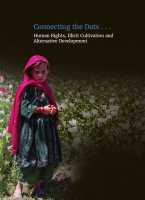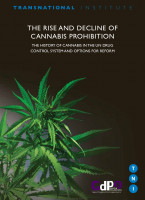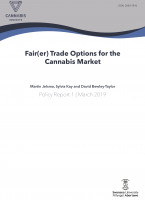A sustainable future for cannabis farmers ‘Alternative Development’ opportunities in the legal cannabis market
Learn how lessening the barriers for small farmers while raising them for large companies can help to steer legal cannabis markets in a more sustainable and equitable direction based on principles of community empowerment, social justice, fair(er) trade and sustainable development.
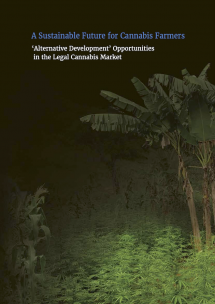
Downloads
Authors
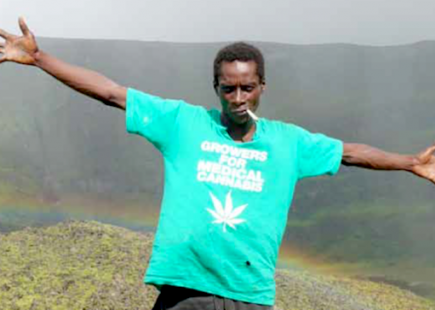
Sylvia Kay
Download the full report in here.
From the early days of cannabis prohibition, traditional producing countries have stressed the importance of finding alternative livelihoods for rural communities dependent on cannabis cultivation. The first crop-substitution projects in the 1960s in Lebanon and Morocco were the genesis of continuing UN debate on ‘alternative development’ and ‘shared responsibility’. Growing demand for cannabis in the North and crashing prices of agricultural commodities like coffee, cocoa and banana due to free trade policies, turned the ever-expanding illegal cannabis market into a survival economy for millions of people. Almost no-where have small cannabis farmers been offered substantial development assistance for moving out of the illegal market.
The recent wave of policy changes and fast-growing legal spaces in the medical cannabis market offer new opportunities for small farmers to transition out of illegality while continuing to grow cannabis. Several traditional producing countries have started to explore this option of ‘alternative development with cannabis’. Barriers to entry, however, are not easy to overcome and few small farmers have been able thus far to conquer some space in the billion-dollar medical cannabis market. The emerging legal markets are increasingly captured by big corporations, pushing out small farmers from the South. This report argues that lessening the barriers for small farmers while raising them for large companies can help to steer legal cannabis markets in a more sustainable and equitable direction based on principles of community empowerment, social justice, fair(er) trade and sustainable development.
Key points & recommendations:
- From the early days of cannabis prohibition, traditional cannabis producing countries have stressed the importance of finding alternative income opportunities for poor rural communities dependent on cannabis cultivation.
- In contrast to projects for illicit coca and poppy cultivation, almost nowhere have small cannabis farmers been offered substantial development assistance for moving out of the illegal market; efforts in the past in Morocco and Lebanon did not have a lasting impact on cannabis cultivation.
- The impact of free trade policies and related price crashes of agricultural commodities like coffee, cocoa and banana, turned the illegal cannabis market into a survival economy for millions of people.
- ‘Alternative development’ in its original sense of shifting to other lucrative crops and income sources is no longer a viable policy perspective for cannabis, if it ever was.
- The recent wave of policy changes and fast-growing legal spaces in the medical cannabis market offer new opportunities for small farmers to transition out of illegality.
- Barriers to entry are not easy to overcome and few small farmers have been able thus far to conquer some space in the billion-dollar medicinal cannabis market.
- Several traditional producing countries have recently started to explore the option of ‘alternative development with cannabis’: Jamaica, St Vincent and the Grenadines, Colombia, Paraguay, Mexico, Ghana, South Africa, Lesotho, eSwatini, Morocco, Lebanon and Thailand.
- The medical market can be divided into four segments with very distinct characteristics and regulatory frameworks: (1) pharmaceutical preparations made from purified cannabinoids; (2) cannabis flower or whole-plant extracts as prescription medicines; (3) cannabis as part of traditional herbal medicines practices; and (4) low-THC / CBD products often sold as health products or dietary supplements.
- The multi-billion dollar global CBD market seems to offer particularly promising prospects for small farmers in traditional producing countries, even though they will have to compete with the highly industrialised and fast-growing hemp industry in Europe, North America and China.
- The INCB (International Narcotics Control Board) - and to a lesser extent the WHO Expert Committee on Drug Dependence - has demonstrated a strong bias in favour of strictly controlled preparations manufactured by the pharmaceutical industry from isolated cannabinoids, rather than herbal cannabis-based medicines and a more accessible model for patients and farmers.
- ‘For many millions of people, herbal medicines, traditional treatments, and traditional practitioners are the main source of health care, and sometimes the only source of care’, according to the WHO; and that is also the case for medicinal uses of cannabis.
- The emerging legal markets are increasingly captured by big corporations, due to the dominance of a ‘Western’ pharmaceutical model for the medical market and an ‘import- substitution’ model for the non-medical market, both pushing out small farmers from traditional producing countries.
- Most companies producing medical cannabis prefer intensive indoor cultivation over collaborating with small farmers currently growing cannabis illicitly, often using strains and cultivation methods that require technical advice and training in order to meet GMP (Good Manufacturing Practise) or GACP (Good Manufacturing and Collection Practise) standards.
- Many plant-based medicines originate from outdoor cultivation by small farmers - including the licit opium poppy cultivation in India and Turkey for the production of opiate medicines - belying the narrative that basic quality standards could not be met by small farmers in the case of cannabis.
- Indoor cultivation also comes with a much higher carbon footprint, given the high energy use and greenhouse gas emissions that follow from continuous indoor lighting and advanced climate control systems, yet another reason to consider changing current cannabis market dynamics.
- Instead of putting all the eggs in the basket of an export-led growth model, countries should pursue a strategy in which as many markets as possible are targeted: foreign as well as domestic; industrial, medicinal and nutraceutical; and - where allowed - also social, religious, cultural and adult uses.
- Countries introducing legal regulation of the cannabis market should cautiously consider the terms under which foreign businesses can participate, at least until a local industry - including small growers - has been able to establish itself; this may require imposing certain restrictions on foreign ownership and investment.
- Legislators and regulatory authorities need to establish special preferential access schemes, such as subsidies, affirmative licensing laws, quotas requiring that a certain percentage of cannabis is sourced from small farmers, and perhaps benefits to companies choosing to comply with principles of social justice and sustainable development.
- Given the barriers to entering a competitive market for the mostly poorly organised and often criminalised traditional farmers, a cooperative form of production would be most beneficial and most empowering for cannabis growing communities.
- The development of a national or regional vision based on inclusive and consultative processes with cannabis farmers, health practitioners, patient groups, legal experts, scientists and other constituencies is critical to set the right framework in place.
- In a positive sign that countries are cautiously reclaiming their long history with cannabis, Morocco, South Africa, India, Nepal, Thailand, Jamaica, Colombia and Mexico in December 2020 all voted in favour of the WHO recommendation to remove cannabis from the strictest Schedule IV of the Single Convention; without their vote the recommendation would not have passed the CND (Comission on Narcotic Drugs) majority vote.
- The fact that even after the WHO review, cannabis still remains in Schedule I means that medical prescription is still obligatory which is an obstacle for traditional medicinal practices, and that cultural and religious uses are still not allowed under the treaty which represents a legal conflict with indigenous, cultural and religious rights.
- Any cannabis policy reform needs to be accompanied by the expungement of criminal records and other measures related to restorative justice for those disproportionately impacted by the War on Drugs, especially indigenous peoples and racial minorities.
- Connecting the dots between the cannabis regulation debate and the sustainable development agenda may still offer prospects for upholding the SDG (Sustainable Development Goals) promise to ‘leave no-one behind’.
- Traditional growers need technical, financial and legal assistance to overcome the multiple barriers they face to get access to legally regulated markets; development agencies should actively and urgently provide such assistance before markets will be captured by big corporations.
- Benchmarking best practices and learning from experiences to lessen the barriers to entry for small farmers while raising them for large companies can help to steer cannabis markets in a more sustainable and equitable direction by attracting responsible investors and lining up suitable buyers and market outlets based on principles of community empowerment, the protection of natural heritage, and fair(er) trade.
- The legacies of colonialism and the particular burden that repressive responses to the illicit cannabis market have placed on countries in the ‘Global South’, need to be taken into account when considering a ‘development with cannabis’ model; it will require an updating of our notions of development and North-South cooperation, based on principles of social justice, fair trade and sustainability.
- Lessons from other markets indicate that private sector-driven development through ‘inclusive business’ models based on global value chains, or voluntary sustainability certification mechanisms, are unlikely to make the cannabis market more sustainable; in the end, legislative and regulatory rules are essential to enforce the basic parameters removing barriers to entry, providing preferential access and compensation, and imposing restrictions to free-market dynamics and corporate capture.





